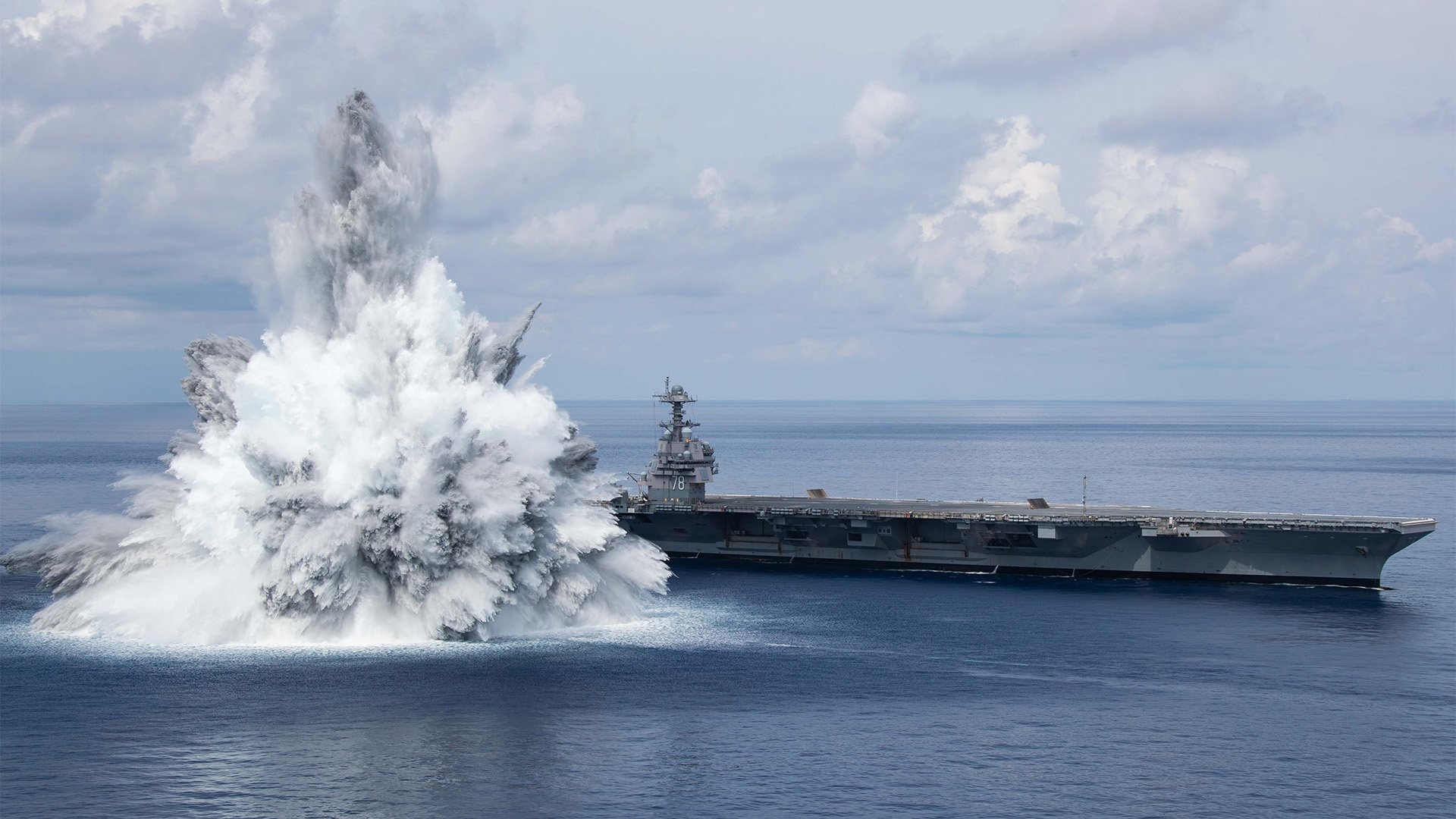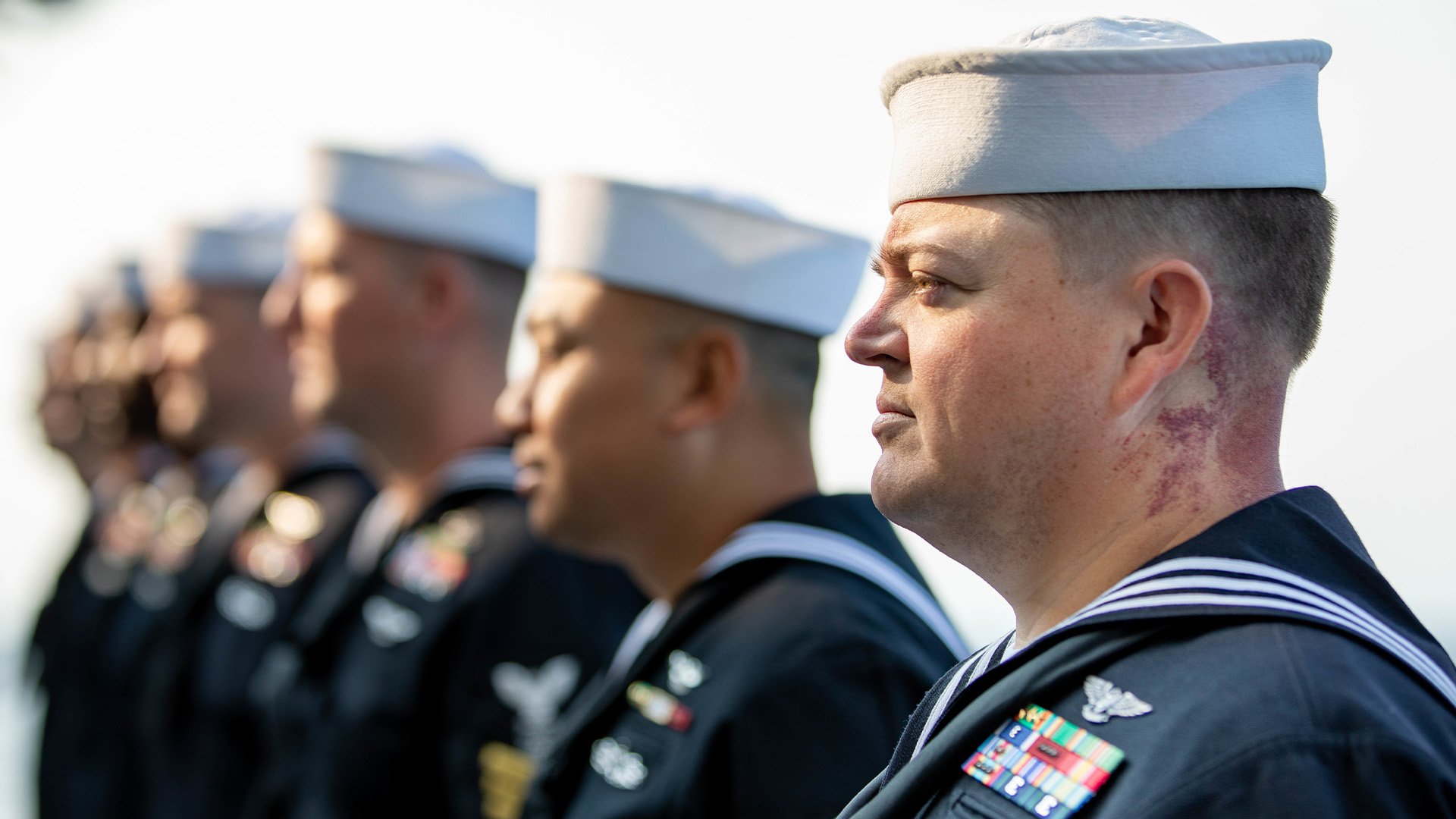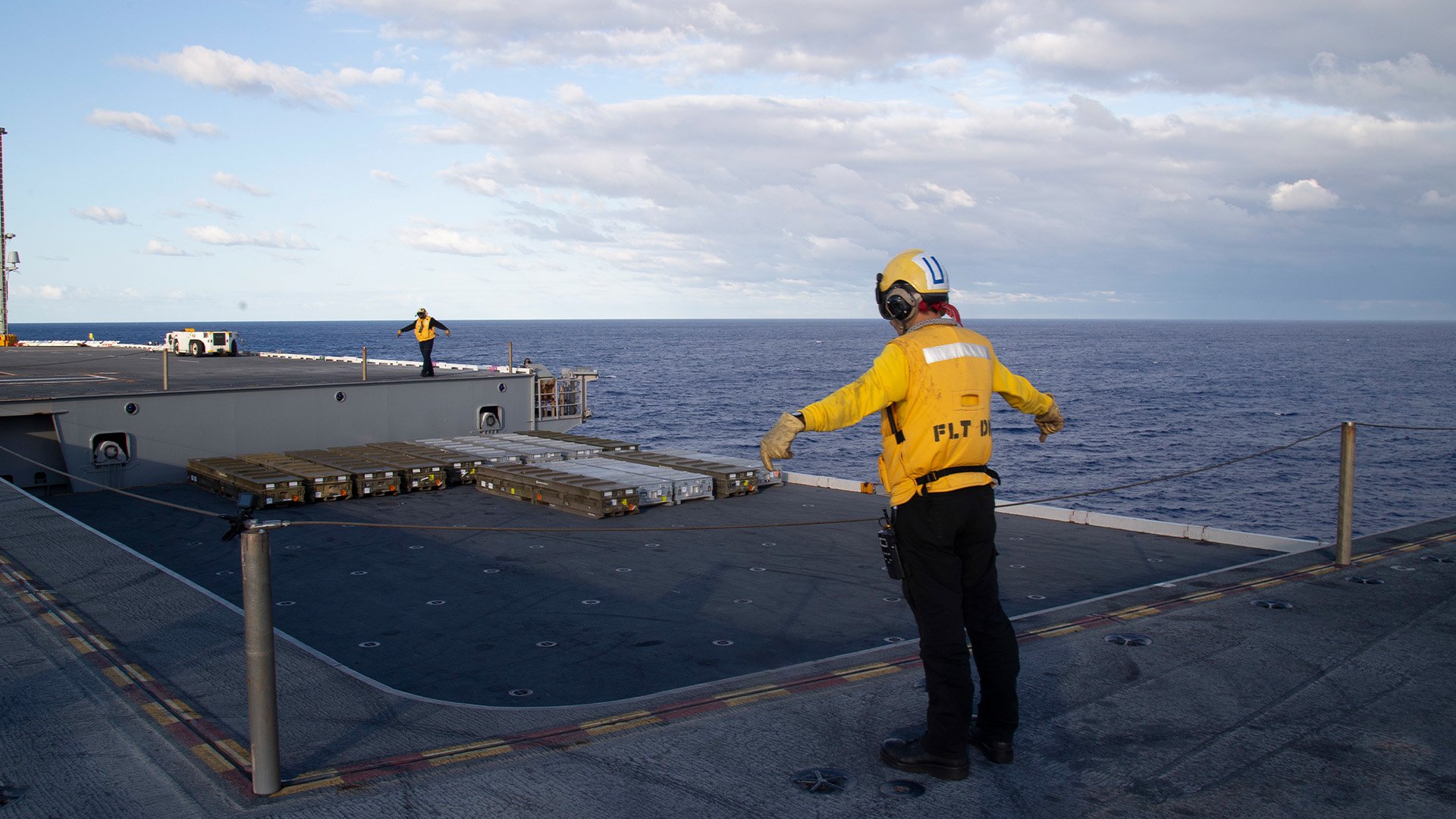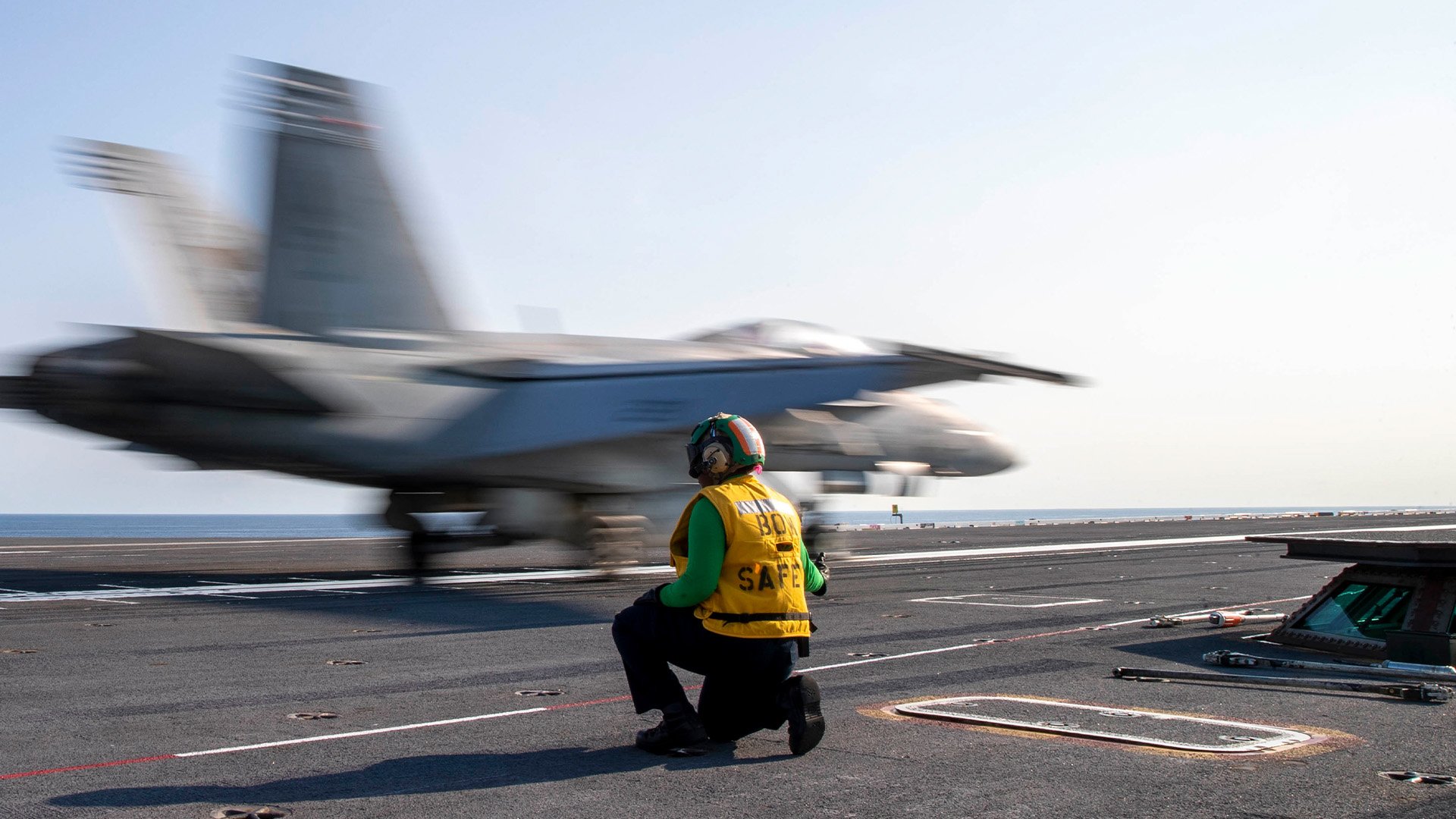Plagued by Technological Glitches, Flattop Ford Finally Set To Sail

The aircraft carrier Gerald R. Ford (CVN 78) successfully completed the third and final scheduled explosive event for Full Ship Shock Trials while underway in the Atlantic Ocean, Aug. 8, 2021. Shock trials of new ship designs using live explosives confirm that US Navy warships will meet demanding mission requirements during battle. US Navy Photo by Mass Communication Specialist 3rd Class Jackson Adkins.
Dogged by cost overruns and delayed by technological glitches, the US Navy’s $13.3 billion aircraft carrier Gerald R. Ford finally gets to depart Virginia on its maiden cruise, five years after it was commissioned into service.
On Monday, Oct. 3, the flagship of Carrier Strike Group 12 is slated to lead a powerful armada of guided-missile escorts — the cruiser Normandy and destroyers Ramage, McFaul, and Thomas Hudner — out of Norfolk into the Atlantic Ocean, where they’ll rendezvous with an unnamed submarine before steaming to Europe.
“The USS Gerald R. Ford Carrier Strike Group will deploy, integrating with allies and partners, to demonstrate its unmatched, multi-domain, full-spectrum lethality in the Atlantic,” Adm. Daryl Caudle, the US Fleet Forces commander, said in a prepared statement.
It’s a teaser tour, what the Navy terms a “service-retained deployment,” and it will likely last a few weeks, not many months. The flattop and its strike group will never exit control of the US 2nd Fleet. A full deployment looms next year, with a fully embarked carrier air wing.
But it’s still a victory for a warship that has become synonymous with procurement pain.

Aviation Ordnanceman 1st Class Loran Kennedy stands at attention as a member of the rifle detail during a burial at sea on board the first-in-class aircraft carrier Gerald R. Ford. Ford was underway in the Atlantic Ocean conducting carrier qualifications and workups for a scheduled deployment on Monday, Oct. 3, 2022. US Navy photo by Mass Communication Specialist 1st Class Spencer Fling.
The lead ship in its class of high-tech carriers, Gerald R. Ford has been plagued with problems, including flaws in its propulsion and electrical systems; dual-band radar that isn’t always reliable; and gremlins spooking its Electromagnetic Aircraft Launch System and Advanced Arresting Gear.
But its biggest headache was caused by weapons elevators that refused to work.
Elevators bring ordnance like missiles and bombs to aircraft, but all 11 of Ford’s elevators weren’t completed, tested, and certified until Dec. 22, 2021, nine months before the warship was set to sail to the North Atlantic.
“Ford is the case study in how not to build a ship,” said Dan Grazier, a fellow at the nonprofit Project on Government Oversight and a longtime critic of the ill-fated flattop. “It teaches us several lessons, including: Do not try to incorporate so much new and unproven technology into a new weapon system. It teaches us that Navy leaders need to be more pragmatic and to seize what’s practical instead of reaching for what’s not fully developed.
“What the Navy did with Ford was really just setting itself up for failure.”

Aviation Boatswain's Mate (Handling) Airman Hudson Bryant, from Covington, Georgia, assigned to the aircraft carrier Gerald R. Ford's air department, signals down an elevator on the flight deck during an ammunition onload Sunday, Sept. 25, 2022. Ford was underway in the Atlantic Ocean conducting carrier qualifications and workups for a scheduled deployment on Monday, Oct. 3, 2022. US Navy photo by Mass Communication Specialist 1st Class William Spears.
Navy leaders and the contractors that designed and built the carrier — more than 2,000 suppliers in 46 states — conceded Ford faced a lot of technological challenges. But they also pointed to the thousands of successful catapult launches and arrested landings over the past several years and the 11 operating elevators as proof it was all worth it.
Ford leaves Norfolk as the most powerful warship ever sailed, a nuclear-powered flattop designed to generate 25% more sorties than the 10 Nimitz-class carriers that entered service between 1975 and 2009, with 25% fewer crew members.
On their first overseas cruise, Ford’s crew will focus on training alongside NATO allies on air defense, anti-submarine warfare, distributed maritime operations, mine sweeping, and amphibious landings, according to the 2nd Fleet.
“This deployment is an opportunity to push the ball farther down the field and demonstrate the advantage that Ford and Carrier Air Wing 8 bring to the future of naval aviation, to the region, and to our allies and partners,” said Rear Adm. Gregory Huffman, the carrier strike group commander.

Aviation Boatswain's Mate (Equipment) 2nd Class Lacarsha Mitchell, from Jacksonville, Florida, assigned to the aircraft carrier Gerald R. Ford's air department, signals safe launch of an F/A-18F Super Hornet from the "Gladiators" of Strike Fighter Squadron 106, Sept. 19, 2022. Ford was underway in the Atlantic Ocean conducting carrier qualifications and workups for a scheduled deployment Monday, Oct. 3, 2022. US Navy photo by Mass Communication Specialist 2nd Class Riley McDowell.
But critics aren’t so sure.
They point to a rising China, which bristles with anti-ship ballistic missiles and continues to build stealthy submarines, as a potential foe that’s figured out how to kill even our most advanced carriers.
“I’m not entirely convinced the age of the aircraft carrier has passed, but the age of the supercarriers has passed,” POGO’s Grazier said. “Partly, that’s because they’re so expensive. The real cost of the Ford, when you add on the embarked aircraft, is really around $25 billion, which is a lot of capital to be putting in one place that can be hit by a missile or torpedo.”
But Big Navy remains positive about Ford, especially what it will mean to allies preparing to command the Atlantic Ocean against a resurgent Russia stalled in Ukraine.
“The Atlantic is an area of strategic interest,” said 2nd Fleet commander Vice Adm. Dan Dwyer in a prepared statement released Thursday. "Our primary goal is to contribute to a peaceful, stable, and conflict-free Atlantic region through the combined naval power of our allies and partners. The deployment of USS Gerald R. Ford’s carrier strike group is the natural progression of our renewed commitment to the Atlantic."
Read Next: Verdict in Bonhomme Richard Arson Trial: Not Guilty

Carl Prine is a former senior editor at Coffee or Die Magazine. He has worked at Navy Times, The San Diego Union-Tribune, and Pittsburgh Tribune-Review. He served in the Marine Corps and the Pennsylvania Army National Guard. His awards include the Joseph Galloway Award for Distinguished Reporting on the military, a first prize from Investigative Reporters & Editors, and the Combat Infantryman Badge.
BRCC and Bad Moon Print Press team up for an exclusive, limited-edition T-shirt design!
BRCC partners with Team Room Design for an exclusive T-shirt release!
Thirty Seconds Out has partnered with BRCC for an exclusive shirt design invoking the God of Winter.
Lucas O'Hara of Grizzly Forge has teamed up with BRCC for a badass, exclusive Shirt Club T-shirt design featuring his most popular knife and tiomahawk.
Coffee or Die sits down with one of the graphic designers behind Black Rifle Coffee's signature look and vibe.
Biden will award the Medal of Honor to a Vietnam War Army helicopter pilot who risked his life to save a reconnaissance team from almost certain death.
Ever wonder how much Jack Mandaville would f*ck sh*t up if he went back in time? The American Revolution didn't even see him coming.
A nearly 200-year-old West Point time capsule that at first appeared to yield little more than dust contains hidden treasure, the US Military Academy said.












